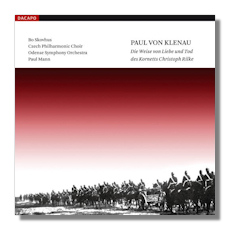
The Internet's Premier Classical Music Source
Related Links
- Latest Reviews
- More Reviews
-
By Composer
-
Collections
DVD & Blu-ray
Books
Concert Reviews
Articles/Interviews
Software
Audio
Search Amazon
Recommended Links
Site News
 SACD Review
SACD Review
Paul von Klenau

Die Weise von Liebe und Tod des Kornetts Christoph Rilke
Bo Skovhus, baritone
Han Skarkoba, soprano
Czech Philharmonic Choir of Brno/Petr Fiala
Odense Symphony Orchestra/Paul Mann
Dacapo 6.220532 Hybrid Multichannel SACD
Executive Summary: Richly expressive, and at times haunting, setting of Rilke's writing. Beautifully performed. Highly recommended.
A pupil of Bruch, Thuille and von Schillings, the Danish composer, Paul von Klenau (1883-1946) was one of so many composers of his time who assimilated a remarkable diversity of compositional tendencies, from impressionism, to the precepts of Schoenberg's 12-tone technique, and yet managed to produce works of great individuality. Klenau was also active as a conductor introducing the music of Debussy, Ravel, Scriabin, Schoenberg and Delius to Danish audiences. He was also a close friend of Berg. While his debt to the music of von Schillings is clear, one can hear faint suggestions of the music of all of these composers in Klenau's work.
Rainer Maria Rilke's text, Die Weise von Liebe und Tod des Kornetts Christoph Rilke (The Way of Love and Death of Cornet Christoph Rilke) dates from 1899 and was first published in 1904. It tells the story of the Cornet (standard bearer) Christoph Rilke during the war against the Turks in 1663. On his journey to join his company he talks with other soldiers about memories of mothers. Later on his way he is awakened by the screams of a bloodied woman (effectively marked by the soprano singing gestures similar to those found in the Seventh Symphony of Vaughan Williams). Before going to war he is seduced by a countess. In the course of battle, he ends up riding ahead of his fellow soldiers and is killed. The work closes with the news of his death being announced in his hometown. While in the years following the First World War, the story was seen as being that of an heroic soldier who dies a glorious death in battle, the story can also be seen as being about a romantic soul who dies a rather meaningless death. It is this latter vision that one hears in the music of Klenau.
Klenau's setting captures the spirit in a most magnificent way. While the music is essentially tonal, it is marked by an occasional reference to quartal harmony, and a resultant ambiguity of tonality. The melodic line is rich and expressive. Phrases are extended to the point where one is reminded of the lack of cadence found in Wagner. The orchestration is rich and sumptuous without being overpowering.
There is a seductive quality to Klenau's setting. It is essentially an extended aria for baritone with occasional comments by the chorus. I found myself lingering with every melodic turn, with every phrase. The mood is broken but a few times to support significant points in the text; as a bugle call summons the soldiers to gather or as the cries of a bloodied woman interrupt the night. There is incredible tenderness as the words express thoughts of the soldier's mother. A haunting motive of remarkable gentleness and beauty accompanies the loss of his innocence. The mood is broken towards the end as he fulfills his destiny as a casualty in war. Then, as death approaches, there are moments of unearthly beauty mixed with the agony of his death. We are left to view the horror of war as almost an abstract notion of violence. In the concluding section, as the messenger approaches Christoph's mother, with the news of his passing, we have an all too brief glimpse of a life lost. It is work that carries you along, not through great contrast, but through the subtle shading of a highly expressive melodic line.
The performances are superb and the recorded sound excellent.
Copyright © 2009, Karl Miller




















